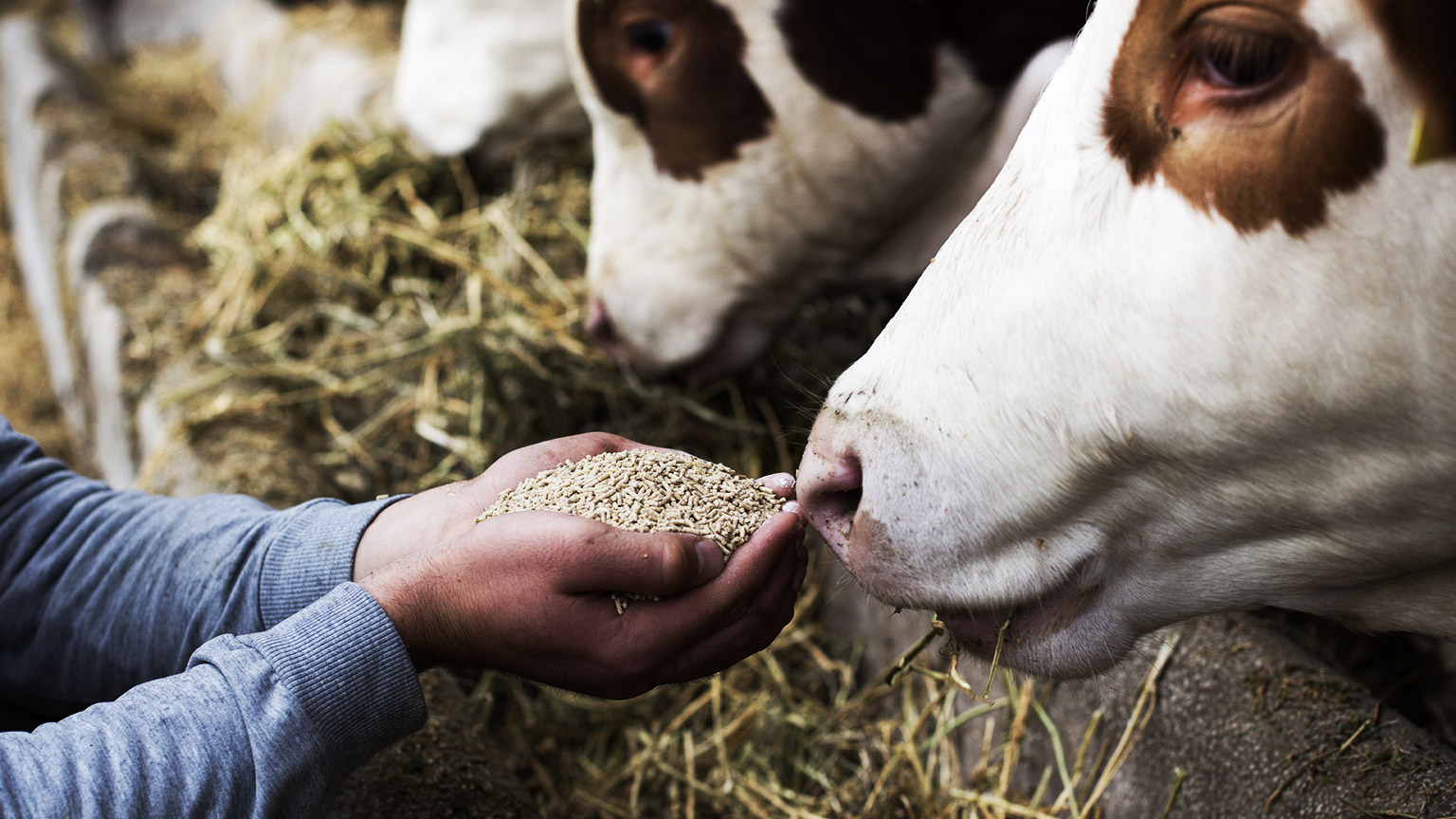Upholding animal welfare principles when feeding
Before delivering the food and water to animals, let’s recap on the overarching eight principles of animal welfare which should guide you at all times in your actions towards an animal when feeding and caring for them.
Consider how the principles of animal welfare in the following table relate to delivering food safely and appropriately.
| Principle | The animal should have access to: | As an animal carer, you should: |
|---|---|---|
| Animals should not suffer from prolonged hunger |
|
|
| Animals should not suffer from prolonged thirst |
|
|
| Animals should have a comfortable environment |
|
|
| Animals should have enough space to be able to move around freely |
|
|
| Animals should be free of physical injuries |
|
|
| Animals should be free of disease |
|
|
| Animals should not suffer pain, fear or stress |
|
|
| Animals should be able to express normal, non-harmful, social behaviours |
|
|
Keeping the principles in mind, when feeding an animal, you must consider how they might react and ensure the animals feel as little distress as possible during this process.
Scenario: Handling Watermelon the guinea pig
Let’s relate the animal welfare principles to how you would handle the guinea pig, Watermelon, should she need hand feeding. First, ask your supervisor to demonstrate appropriate handling techniques for guinea pigs or read Handling your guinea pig to ensure you don’t cause her injury or stress. She will squeal in protest if you do or even bite you if she is frightened or feels threatened.
Approach her with two hands, using one to stop her from running forwards and the other backwards. As you pick her up, use one hand to support her tummy and the other to support her hindquarters, hugging her into your body or wrapping her in a cloth for security. You could then feed her knowing that you are safe and she feels safe because she is being handled appropriately and respectfully (Bishops Stortford Vets, n.d.).
The following video (1:25 min) demonstrates a safe way to pick up and support a guinea pig.
Before you handle any animal in your care, ensure you always seek training and knowledge on the unique characteristics of the particular animal and seek advice from your supervisor if in doubt.
Last checks before providing food and water
At this stage, you should be ready to feed and water the animals in your workplace according to their feeding plans. It is important to re-read the plan at this point to double-check that you:
- are feeding the correct animal the correct food
- identify potential hazards and behaviours of concern
- are wearing any PPE that you may need.
You must also read the workplace policies and procedures for monitoring animal feeding. The policies and procedures are in place to help you quickly identify health and behaviour problems or changes. Source this information in your animal care workplace, read it and implement it.
Review example procedures in the Daily Animal Health Monitoring Program (pdf) from the University of Wisconsin – Madison School of Veterinary Medicine. Pay careful attention to the monitoring process from the beginning to the end because this will prepare you for your own workplace (University of Wisconsin Madison, 2015).
After carefully considering your feeding plan and workplace policies and procedures, you will now know if you need to put on PPE, how to approach the animal you are feeding safely, and what you need to observe, monitor, and record when feeding the animal or animals in your care.
How to deliver food in a manner that is safe and appropriate to the animal
Before commencing feeding any animal, it is essential to be aware of potential hazards that may exist or occur in food distribution. Consider the following hazards to animals and humans in food distribution.
Common hazards
- Animal movement and handling
- Excessive noise
- Organic and other dust
- Possibility of zoonotic infection
- Sharps injuries (cuts and stabbing)
- Temperature when handling foods and when serving foods to animals
- Amounts given (too little or too much)
- Slipping on water or food spills
- Medications (giving incorrect medication or not medicating animals when needed)
- Zoonotic diseases (not wearing the correct PPE when placing foods into cages)
- Manual handling
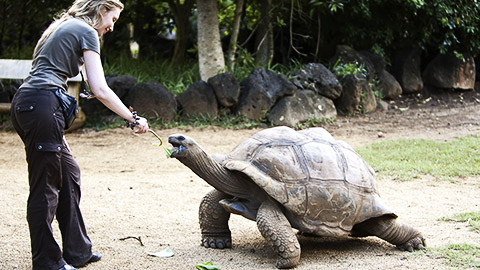
Hazardous animal behaviour during feeding
In the animal care industry, you need to understand animal temperaments and behaviours related to the associated hazards and risks to animals and staff during animal feeding.
It’s easy to evaluate animal behaviour by remembering three categories, as identified by the Madison Shelter Medicine Program:
- Interaction with people – how is the animal responding to you, and how has it responded to people previously?
- Acclimation – how is the animal responding to their new environment?
- Approachability – do you feel comfortable approaching this animal? Will you be safe? (University of Wisconsin Madison, 2015)
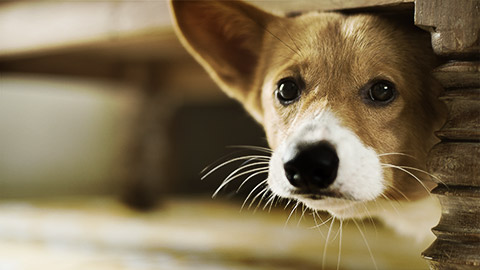
Cage cards, warning labels and animal histories will hold information about handling animals. Therefore, it is essential to read these to ensure you choose the best PPE and handling techniques for individual animals when feeding.
The following table summarises some common behaviours. Observe if your animal is displaying any of the following characteristics of animal behaviour and alter your approach to the task at hand accordingly.
| Indictors of confidence and willingness to be approached | Indicators of stress | Submissive gestures | Defensive gestures |
|---|---|---|---|
|
|
|
|
You must understand the characteristics of the species and breeds you work with and know how to reduce the risks. For example, if you work with cats, make sure you have had training in and understand cat behaviour.
Indicators of Stress in Cats (pdf) from Daily Monitoring of Communal Cat Rooms is a good example of the type of detailed information you will need before approaching an animal.
Seek out the behavioural information relating to the animals in your care in your own workplace to keep yourself and the animal safe before, during and after feeding and watering.
You should only work with species you are trained in and refer to any organisational policies and procedures pertaining to use of PPE and safe handling of animals.
Verbally report hazards or incidents you encounter to your workplace supervisor. If advised, use the appropriate work health and safety hazard, risk or incident form to fill in and hand to your WHS officer within the time frame as determined by your animal care workplace.
Your supervisor should take appropriate measures to ensure that this hazard or incident is dealt with and resolved efficiently and correctly.
Scenario: Bandit
Bandit is a 4 kg, 2-year-old domestic short-haired cat boarding at ABC All Animal Boarding. It is his first time boarding and he is highly stressed, resulting in him lashing out, trying to escape, hiding and being very unpredictable in his behaviour.
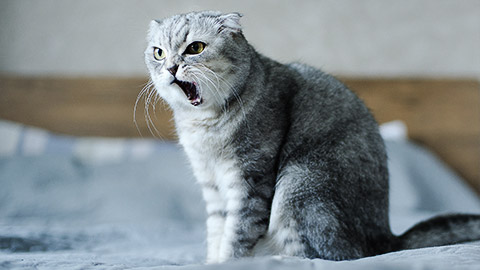
You have provided his cat crate with the door off for him to hide in and Feliway spray is applied three times a day to his cage.
You notice that he has tipped over his water bowl. So, you will need to supply him with more water. What would be the safest way to complete this task?
Steps to eliminate hazards
- Assess his behaviour. However, given he is so unpredictable, he could trick you.
- Read his cage card and history to see if anyone has made notes on their successes in handling him. You could also ask other staff for updates.
- Once you are ready to approach Felix’s enclosure, ensure all doors are closed to the cat ward if he manages to escape his enclosure. If he is in his cat crate, you could insert the door so that he is confined in his crate.
- Apply PPE such as cat gloves.
- Remove the empty bowl and replace it with a fresh one, so the door is open for less time.
- Remember to release him from his crate.
- Ensure you are moving calmly, quietly and with purpose at all times.
- If you have a break in looking after Bandit, ask other staff for an update on his behaviour upon return to your feeding role.
Select and correctly fit appropriate personal protective equipment
Once you have prepared the food, re-read the feeding plan and take note of your animal’s behaviour. Now it’s time to consider what personal protective equipment (PPE) you need to deliver the food, feed supplements and water safely.
PPE is one of the levels of the hierarchy of control in controlling the spread of infection. Using the PPE will help minimise exposure of the veterinary and animal care staff to pathogens by decreasing the contamination of clothing and skin. It is also a barrier between you and the animals’ natural weapons, such as talons, teeth, nails, hooves and beaks. Make sure all your PPE is correctly fitted before use. Otherwise, items like gloves or boots may produce further hazards by slipping off or tripping the wearer.
Common PPE in the animal care industry
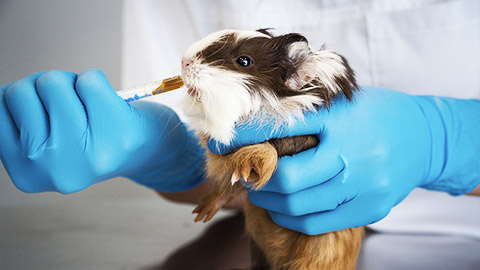
Six common examples of PPE equipment and clothing used in veterinary or animal care practices to reduce the spread of infection include:
- Gowns (non-sterile)
- Lab (over)coats
- Scrub suits/tops/overalls
- Gloves
- Masks and glasses
- Footwear
Gowns (non-sterile)
Non-sterile gowns will provide you more protection than a lab coat or a scrub top and are mostly used in association with gloves and masks when barrier nursing and handling animals that are suspected of having an infectious disease.
Lab (over)coats
In veterinary and animal care practices, lab (over) coats should be worn when handling animals if there is no chance of splashing liquids.
Scrub suits/tops/overalls
Scrub suits, tops and overalls are more frequently used in veterinary clinics as protective wear. Their use means that everyday clothes cannot be contaminated. Overalls would commonly be used when dealing with large animals or in a kennel facility.
Gloves
Gloves, whether they are powdered or non-powdered will reduce the risk of contamination. It is important that these are worn whenever there is a possibility of contact with any raw foods. Leather and other types of thick gloves are commonly used as a physical barrier. Ensure you select the right size for your hands, so they don’t slip off or constrain you while wearing them.
Mask and glasses
Correctly fitting masks and glasses to protect your respiratory tract and eyes. Follow the instructions to ensure they are fitted correctly and protect you sufficiently.
Footwear
Many forget that correctly sized footwear plays an important role in daily PPE. The type of footwear to use depends on the animal and situation you are working in. For example, if you are dealing with large animals or working in a shelter you may wear boots, such as reinforced-toe boots or gumboots.
At a clinic or doggy day care wearing non-slip closed-in shoes would be sufficient. Footwear protects your feet if you stand on items and if an animal stands on your foot or you drop a sharp item.
Examples of PPE in feeding animals
The following are a few examples of animals and the minimum PPE you should wear when feeding them:
- Guinea pigs – gloves
- Cats and dogs – gloves, long pants and boots or non-slip closed-in shoes and hearing protection in a kennel situation
- Horses – fully enclosed footwear such as leather work boots or steel caps and an approved high visibility vest.
When should PPE be used?
As useful as PPE is, it is one of the least effective control methods for protecting the user from risks. Therefore, PPE should only be used:
- as a last resort when the other control measures are not practical
- as an interim measure until a more effective way of controlling the risk can be used
- to supplement higher-level control measures.
Using protective equipment is vital, however, when working with animals who are known to be aggressive, especially if the animal requires restraint. Your workplace will have procedures related to the types of PPE you need to wear to stay safe at work and when to wear it. Always ensure you wear PPE correctly and ensure it is correctly fitted to provide the maximum level of safety for the task.
Review the video PPE for equine veterinarians (5:23 min), which explains how to evaluate an animal’s health in order to select the appropriate PPE.
Food and water vessels
Now it’s time to choose how you will present the food and water to the animal you are feeding. Your animal care workplace will already have dedicated feeding vessels. Which one you select will be dependent on the species, breed, age, medical needs and activity levels of the animal. You should be aware of the pros and cons of the selection.
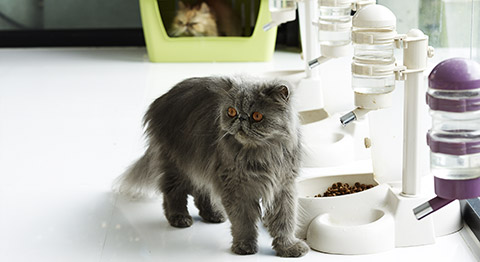
Considerations when selecting vessels
- Choose the material of the vessels carefully by understanding the characteristics of the species being fed. Stainless steel bowls are not only the most hygienic material as they are easily cleaned but also less likely to be damaged by animals chewing them. Ensure the vessel can’t be tipped or knocked over by the animal, in which case heavy ceramic bowls may be more suitable than stainless steel and plastic.
- Consider if the animal prefers a particular vessel.
- Consider the type of food being presented. For example, a liquid diet may require syringe delivery, whereas hay may need to be presented in a net.
- Specific medical needs of the animal will determine the type of vessel needed. For example, a raised bowl may be required for eating and swallowing conditions.
- Select an appropriately sized vessel for the animal.
- Food and water vessels are to be undamaged so as not to leak. Therefore, inspect them each day before use.
- Make sure food and water vessels are clean. Food vessels are to be dry before use when feeding an animal dry food.
- Consider how the vessel will be secured and where it will be placed. For example, will the vessel be hung on a cage or placed on the ground? Should it be placed in the shade?
- Carefully choose the location of water in relation to the food so it cannot be contaminated. For example, ensure food is not placed in a toileting area.
- Consider how many animals are being fed in one location.
- Water vessels are to be suitable for the animal and placed in such a way as to prevent leakage. For example, a guinea pig will need a drip water bottle and some cats prefer running water, such as a water fountain.
Scenario: Feeding vessels for Watermelon
Like other guinea pigs, Watermelon places her front teeth on the bowl’s rim. Therefore, a ceramic bowl is the most appropriate choice for a feeding vessel. The weight of the bowl will stop it from being tipped over and she cannot chew it (The Humane Society of the United States n.d.).
For more information about how to choose appropriate bowls for cats and dogs, review the article, 'How to Choose the Right Bowl for Your Dog'.
Feeding methods
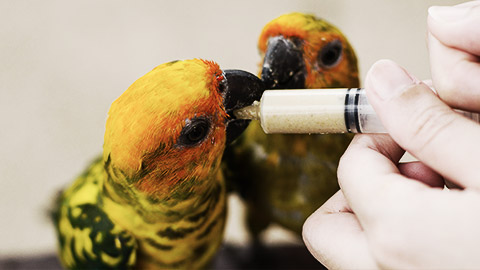
Always follow the feeding method outlined in the animal’s feeding plan. Feeding methods that are appropriate for the animal will depend on the animal's species, breed, age, and medical needs. Some common examples of feeding techniques for cats and dogs of various ages include:
- Hand feeding – to give food in fixed amounts and at a fixed time rather than allowing animal to self-feed. Often used when an animal is picky or has inappetence to encourage feeding, such as tweezers in the case of reptiles.
- Adlib feeding, free feeding, free-access feeding, or grazing – where food is always available and the animal can choose when to feed. Care should be taken that the animal is only allowed access to its daily energy requirements to avoid overfeeding.
- Bottle feeding – feeding from a bottle, commonly used in neonates such as when hand rearing kittens, calves, foals and puppies.
- Controlled feeding or scheduled feeding – animals are given food at an allocated time of day whether once, twice or more times in the day.
- Liquid diet – food is provided in a liquid form. This would be used when an animal is recovering from jaw or mouth surgery or after inappetence.
- Restricted diet or limited feeding – the animal is offered a certain amount of food as a single portion at a fixed time of the day.
Animal feeding methods
Review the following articles for more information about how to feed cats:
Review the following articles about different feeding methods for other species:
- Recommended Feeding Methods of Companion Birds
- Hand-feeding Methods & Tools
- Winging It: A Parenting Test for Guam Kingfishers
- Oryx Calf Update: Bottle Feeding Q&A.
- Ferret Food & Water Bowls: How To Pick The Best Ones?
- Equine Feeding Management: The How & When of Feeding Horses
Knowledge check 5
Complete the following two (2) tasks. Click the arrows to navigate between the tasks.
Check and maintain food and water supply
When giving food to your animal make sure that it is out of direct sunlight and away from contaminants such as dirt, soil and rubbish.
Position food and water vessels to avoid any spillage or contamination by urine or faeces. Ensure that vessels are always clean and free from contaminants. You will need to move them to a more appropriate area if they are not. Animals often overturn food and water bowls. Make sure the bowls are secured to stop this from happening.
Food and water are to be checked regularly to ensure they remain fresh and clean by replenishing when needed. During the summer months food and water is to be checked and changed more frequently. Food spoilage will be more rapid, and water will warm quickly. Ice blocks can be added to the water when experiencing high temperatures. Always ensure there is plenty of clean, fresh water available to avoid an animal getting dehydrated (except those undergoing treatments that require no water intake).
All uneaten food should be removed promptly to avoid any spoilage, attraction of vermin and food poisoning.
Once you have checked an animal’s food and water supply, you must record this on the animal’s record sheet including any replenishment.
Monitor feeding process to ensure animals are feeding effectively
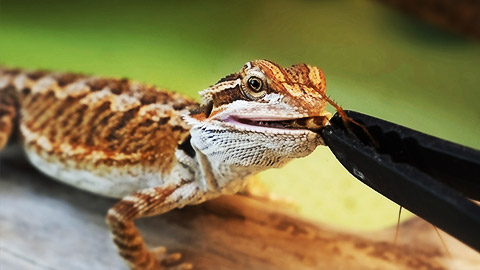
When food is placed into the animal’s cage, it will be recorded on the animal’s record monitoring chart with the date, time, type of food, amount given, and details. This will ensure that the animal is not over or underfed or watered. This food and water monitoring is performed manually by the person who fed the animal.
There are eight (8) common things that you may need to observe and record about how a particular animal eats and drinks:
- The time you provided food and water
- The type of food (and fluid, if not water) you provided
- The amount of food and water you provided
- The amount of provided food and water that was consumed by the animal
- Whether the animal has difficulty obtaining the food, chewing or swallowing food and/or water
- Any patterns in eating habits and behaviours
- Variations or abnormalities relating to individual eating and drinking patterns, such as vomiting
- Whether the animal has defecated or urinated (as an indication of the animal processes nutrients).
Review the following examples of daily monitoring sheets from Shelter Medicine, School of Veterinary Medicine at the University of Wisconsin-Madison to understand the details required in monitoring animals in the workplace:
All animals should have their weight recorded upon arrival at a facility. Animals should then be weighed at the same time daily to ensure that the appropriate weight is maintained according to the animal’s problem (for example, losing weight in an obese animal, gaining weight in a puppy or kitten and maintaining weight in the healthy or sick animal). This will also determine how effective the food that they are given is.
Knowledge check 6
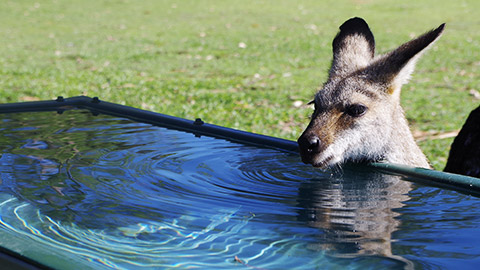
Observe variations in individual eating and drinking patterns and inform supervisor
It is not uncommon for animals staying within new environments to become fussy or refrain from eating and drinking. Learning tips and tricks to make food more appealing to animals is essential. Some animals will feel overwhelmed if offered too much food, so offering smaller meals more often can be a great way to tempt them to eat. Cats are nocturnal by nature, and it is not uncommon for stressed cats to only eat at night. 13 Tips for How to Get a Cat to Eat EVERY Time is a fantastic article on how to encourage cats to eat. The techniques discussed can be used for a variety of species.
Recording all information on the animal’s record sheet, especially any unusual behaviour or eating patterns, is essential. Make a general observation of sick animals, taking note of weight loss, diarrhoea and ill thrift. Observations may also reveal the animal has been vomiting, regurgitating, or has constipation. It is extremely important to verbally report any unusual behaviours to your supervisor as soon as you notice them prevent further decline. An animal may need to be referred to a veterinarian for further examination.
Eating and drinking abnormalities may include:
- gorging
- increased water intake
- reluctance to eat
- reluctance to eat previously accepted foodstuffs.
Your observations may reveal that some animals prefer or need to have wet or can food over dry food. This needs to be noted down on the animal’s record chart, so the appropriate type of food is given.
Remember, also, that some animals are frightened and may only eat when it is quiet and no one is around (for example, overnight).
Recording this information should be done manually on the animal’s record sheet located in the animal’s folder on their cage. Any variations to the animal’s eating and drinking patterns, including abnormal behaviours or physical abnormalities should be recorded and immediately reported verbally to the supervisor and then, if applicable, to the animal’s veterinarian (Hollinger H., 2022).
Scenario: Observing Watermelon’s feeding habits

One afternoon, you notice that Watermelon she had not eaten any of her previous meal, there is evidence of diarrhoea in her cage and she is not her usual active self.
You should record this information on her cage card and report it your supervisor. The following cage card is an example of how you could record this information.
| ABC All Animal Boarding | ||||||
|---|---|---|---|---|---|---|
| Animal name: Watermelon
|
Owner name: Truss Owner number: 0400 800 800 |
Species: Cavy (guinea pig) Breed: Satin Age: 1 year Colour: Golden |
Sex: Female Desexed: No Weight: 470 g |
|||
| Stay | Feeding | Services | ||||
|
Date in: 18/07/2022 Date out: 01/08/2022 |
Product: Fresh vegetables (named container in the fridge) Amount: 1/2 cup per meal Frequency/timing: Morning and evening |
Hydrobath - flea/tick: No Hydrobath - medicated: No Hand bath: No |
Clip (details): No Nail clip: Yes |
|||
| Vaccinations | Preventative health | Medication / supplements | ||||
|
Due date: n/a Type: |
Product: Due date: |
Product: Vitamin C powder Dose: 1/2 scoop daily Timing: Evening, on food |
||||
| Notes: | ||||||
| Date | Eat | Drink | Urine | Faeces | Medication | Notes: |
| 18/07/2022 am | ✔ all | ✔ | ✔ | ✔ | ||
| 18/07/2022 pm | ✔ half | ✔ | ✔ | ✔ | Vitamin C powder | |
| 19/07/2022 am | ✘ none | ✔ | ✔ | ✔ Runny | Lethargic | |
Knowledge check 7
Complete the following three (3) tasks. Click the arrows to navigate between the tasks.
